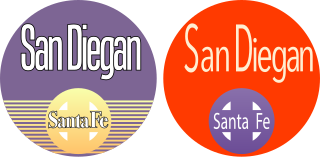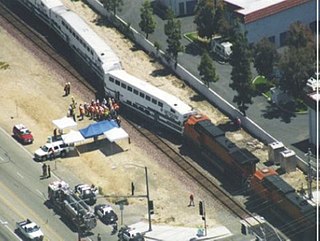Related Research Articles

The San Diegan was one of the named passenger trains of the Atchison, Topeka and Santa Fe Railway, and a “workhorse” of the railroad. Its 126-mile (203-kilometer) route ran from Los Angeles, California south to San Diego. It was assigned train Nos. 70–79.

The Budd Company was a 20th-century metal fabricator, a major supplier of body components to the automobile industry, and a manufacturer of stainless steel passenger rail cars, airframes, missile and space vehicles, and various defense products.

Cajon Pass is a mountain pass between the San Bernardino Mountains to the east and the San Gabriel Mountains to the west in Southern California. Created by the movements of the San Andreas Fault, it has an elevation of 3,777 ft (1,151 m). Located in the Mojave Desert, the pass is an important link from the Greater San Bernardino Area to the Victor Valley, and northeast to Las Vegas. The Cajon Pass area is on the Pacific Crest Trail.

The Budd Rail Diesel Car, RDC, Budd car or Buddliner is a self-propelled diesel multiple unit (DMU) railcar. Between 1949 and 1962, 398 RDCs were built by the Budd Company of Philadelphia, Pennsylvania, United States. The cars were primarily adopted for passenger service in rural areas with low traffic density or in short-haul commuter service, and were less expensive to operate in this context than a traditional diesel locomotive-drawn train with coaches. The cars could be used singly or coupled together in train sets and controlled from the cab of the front unit. The RDC was one of the few DMU trains to achieve commercial success in North America. RDC trains were an early example of self-contained diesel multiple unit trains, an arrangement now in common use by railways all over the world.

The El Capitan was a streamlined passenger train operated by the Atchison, Topeka and Santa Fe Railway between Chicago, Illinois, and Los Angeles, California. It operated from 1938 to 1971; Amtrak retained the name until 1973. The El Capitan was the only all-coach or "chair car" to operate on the Santa Fe main line between Chicago and Los Angeles on the same fast schedule as the railroad's premier all-Pullman Super Chief. It was also the first train to receive the pioneering Hi-Level equipment with which it would become synonymous.

The San Bernardino train disaster, was a combination of two separate but related incidents that occurred in San Bernardino, California, United States: a runaway train derailment on May 12, 1989; and the subsequent failure on May 25, 1989, of the Calnev Pipeline, a petroleum pipeline adjacent to the tracks which was damaged by earth-moving equipment during the crash cleanup.

The Naperville train disaster occurred April 25, 1946, on the Chicago, Burlington and Quincy Railroad at Loomis Street in Naperville, Illinois, when the railroad's Exposition Flyer rammed into the Advance Flyer, which had made an unscheduled stop to check its running gear. The Exposition Flyer had been coming through on the same track at 80 miles per hour (130 km/h). There were 45 deaths and some 125 injuries. This crash is a major reason why most passenger trains in the United States have a speed limit of 79 mph (127 km/h).

On February 6, 1951, a Pennsylvania Railroad train derailed on a temporary wooden trestle in Woodbridge, New Jersey, killing 85 passengers. It remains New Jersey's deadliest train wreck, the deadliest U.S. derailment since 1918, and the deadliest peacetime rail disaster in the United States.
The Frankford Junction train wreck occurred on September 6, 1943, when Pennsylvania Railroad's premier train, the Congressional Limited, crashed at Frankford Junction in the Kensington neighborhood of Philadelphia, Pennsylvania in the United States, killing 79 people and injuring 117 others.

The Rockport train wreck occurred in Rockport in Mansfield Township, New Jersey, United States, about three miles outside of Hackettstown, on June 16, 1925. A violent storm washed debris onto a grade crossing, derailing a Lackawanna Railroad (DL&W) train. The crash killed 42 passengers and five crewmen and injured twenty-three others.

The California Central Railway was incorporated on April 23, 1887, with headquarters in San Bernardino, California. George O. Manchester was the President of the corporation.


The 2015 Philadelphia train derailment of a New York City-bound Amtrak train in Kensington, Philadelphia, Pennsylvania in the United States resulted in multiple passenger injuries and deaths and disrupted Amtrak service for several days afterward due to the resulting investigation and removal of the wrecked train cars.

The 2002 Placentia train collision occurred at around 8:10 am. PDT on April 23, 2002, when a Burlington Northern Santa Fe freight train and a Metrolink commuter train collided head-on at Control Point Atwood in Placentia, California, United States.
References
- 1 2 http://www.theeastsiderla.com/2009/01/tragic-piece-of-railroad-history-rolls.html A tragic piece of railroad history rolls back to Los Angeles
- ↑ http://wikimapia.org/9945366/Santa-Fe-Derailment-Redondo-Junction-site Santa Fe Derailment: Redondo Junction
- ↑ "The Santa Fe Train Wreck Introduced the Public to Live TV Coverage". Archived from the original on 2013-07-25. Retrieved 2014-06-16. Santa Fe Train Wreck
- ↑ Railroad Wrecks by Edgar A. Haine, p133-4, publ 1993, ISBN 0-8453-4844-2